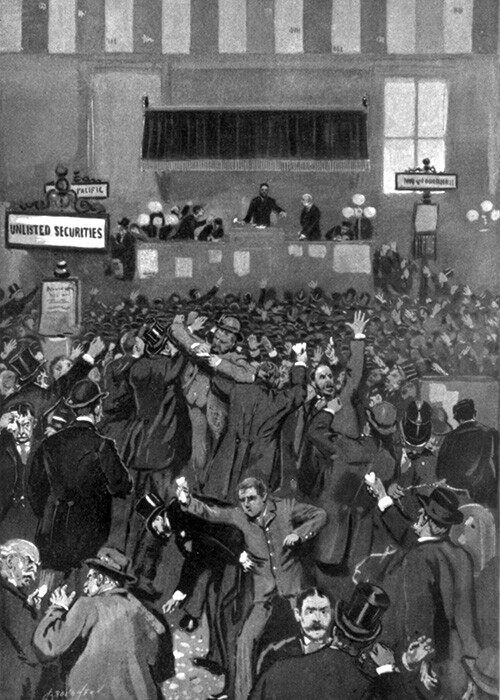Our ancestors’ lives were often impacted by the economic, social, and worldwide events surrounding them. If you had ancestors living in the United States around the 19th century, they were probably affected by the financial panic of 1893, one of the most severe depressions in U.S. history. Let’s look at how this event impacted the economy and society of the United States and what resulted from it.
What Is a Financial Panic?
A financial panic is a sudden, drastic, widespread economic downturn. Simply put, a financial panic happens when a variety of events cause people to feel and become financially insecure. In a financial panic, bank depositors withdraw their money and investors sell their stocks.
Although financial panics have occurred throughout history, several complex reasons typically cause a panic to happen. Panics also vary in degrees of severity and length.

What Caused the Panic of 1893?
The decades of the 1870s and 1880s were marked by economic progress and industrialization, with increased production of steel, petroleum, fuel, metals, railroads, and new ways to communicate. It was also a time of financial speculation and changes in American society caused by moving from a largely agricultural society, especially in the southern and western areas of the country, to an industrial economy.
During the 1890s, circumstances developed that eventually led to the depression of 1893, which lasted until 1897. But what really caused the panic of 1893? Let’s take a look at a few causes of this financial panic.
McKinley Tariff and European Recession
In 1890, a recession engulfed France, England, and Germany, speculations in Australian, South African, and Argentine properties collapsed. These events caused an economic contraction that impacted the United States. With the crisis in Europe, foreign investors began selling their American stocks for gold, which was considered by many as the only reliable form of currency. In addition to the recession in Europe, President Harrison signed the McKinley Tariff into law in 1890, raising the tariff rate to almost 50 percent. The rates resulted in increased prices in the United States, compounding economic issues.
Gold and Silver Issues

The Sherman Silver Purchase Act, signed into law in July 1890, was designed to increase the money supply. At the time, the United States was on the gold standard, meaning that notes issued by the U.S. Treasury could be redeemed for a fixed amount of gold. With the Silver Purchase Act, the government was obligated to buy millions of ounces of silver, and treasury notes could be redeemed in either silver or gold. The increased supply caused silver prices to go down, and investors redeemed treasury notes for gold rather than silver. With European investors also trading in their stocks for gold, U.S. gold reserves were seriously depleted.
Slowdown in Railroad and Other Construction
During the 1880s, railroad building boomed along with its associated industries and opened remote areas of the country for farming. Due to overbuilding, the railroad expansion slowed down in the 1890s and caused a decline in construction-related jobs and investment opportunities.
Agricultural Woes
In addition to the economic slowdown, agriculture products also took a hit after a decade of expansion. The price for the wheat crop of 1891 was high, but between 1892 and 1893, prices had tumbled due to storms, drought, and overproduction. The decline in prices caused grave financial problems for farmers dealing with mortgage debt and trade deficits. Purchasing power for goods and services decreased.
What Were the Results of the Panic of 1893?
Bank and Business Failures
As the economy slowed, people withdrew their money from banks to secure their savings. The run on the banks caused an estimated 500 banks to close. Along with bank failures, the demand for goods declined, causing approximately 15,000 businesses to fail, including several railroads.

Unemployment
Nearly 20 percent of the U.S. population was unemployed. For example, unemployment rates reached nearly 25 percent in Pennsylvania and 35 percent in New York. In addition, many farmers lost their farms when banks foreclosed on their mortgages.
Strikes and Protests
Several strikes and marches occurred due to the depression, such as the Pullman Strike, and protests and marches on Washington, D.C., such as Coxey’s Army.
Charity Organizations
Soup kitchens were organized by churches to feed the hungry. Social programs, such as the charity organization movement, helped with the needs of those affected by the depression and urban poverty.

Effect of the Panic of 1893 on Society
Although the depression began to lift in 1897 as gold reserves increased and the demand for American crops and products in Europe improved, industry and commerce took time to recover.
The panic of 1893 contributed to the Progressive movement in the United States and the rise of labor unions, along with increased manufacturing, government, and banking reforms. The idea that the government should provide social programs and safety nets became popular as a result of the panic and continuing changes to society.
Find Your Ancestors Who Were Alive during the Panic of 1893
To learn more about your ancestors during this period, be sure to check the 1900 United States census. You can also explore your ancestors’ local histories and the newspapers where they lived to understand the impact of the financial panic on them. You might be surprised at what you find, and you will develop a greater connection to your ancestors as you understand their challenges and triumphs.
As you learn about your ancestors and what they experienced, be sure to share your findings on your FamilySearch family tree so others can learn and be inspired by their challenges and achievements too.




